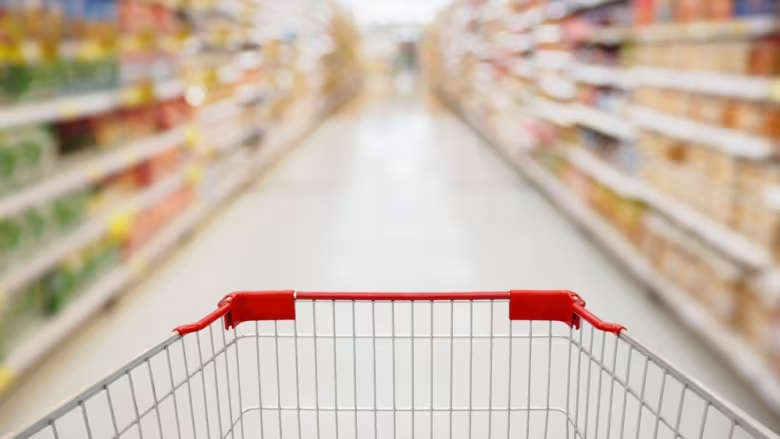Yukon ‘data guy’ compares grocery bills to see how much more he’s paying this year

By · CBC News
A cart full of basic food items at Brett Elliot’s local supermarket has gone up 12% in a year
A Yukoner tracking the price of food staples at his local supermarket found a price rise over the last year that’s more than double the rate of inflation.
Self-described “data guy” Brett Elliot compared the price of 37 food items at a major Whitehorse supermarket between October 2022 and 2023.
He found, on average, the same shopping trolley went up 12 per cent in price, disregarding sale prices.
“The biggest driver, the biggest price increase, was chicken breast,” he said.
“It almost doubled in the last year. Last year, you could get a kilogram of chicken breast for around $9 and this year it’s almost $17. So that was a huge price difference. Also — ground beef. Last year, at one kilogram you found it for about $8 and this year it’s up to $14.”
Orange juice jumped from $4.19 to $6.29, and a kilogram of Royal Gala apples, once $4.39, now cost $6.60.
Even Kraft Dinner had climbed in price, he said, from $1.57 to $2.29 a pack.

The project started mostly out of curiosity, Elliot said.
“I started doing a lot more of the shopping for my household in the past couple years and I noticed the prices were going up and up. As a data guy myself, I figured that everyone’s talking about the prices increasing. But I wanted to be able to quantify it and see exactly how much they were increasing,” he said.
“There’s pharmacy items in there, there’s meat items, there’s produce items, there’s cookies and crackers and that sort of thing too. So it’s mostly meant to represent a wide spectrum of what you’d be able to find in a grocery store.”
Elliot found seven of his chosen items remained the same price, and seven decreased in price.
Among them was a “welcome decrease” in the cost of a dozen eggs he said, from $5.09 to $3.89, and a litre of milk dropped from $2.89 to $2.79.
Thanksgiving basics put to the test
CBC Yukon accompanied Elliot on a trip to his local supermarket to buy seven basic Thanksgiving ingredients — a large turkey, stuffing, cranberry jelly, two small pumpkin pies, whipped cream, four large potatoes and a can of peas and corn — enough for about four to six people.
The total came to $62.40.

The shopping trip did not include cooking products such as butter, oil, seasoning spices and baking paper. It also excluded drinks and snacks.
“If you’re looking at like, you know, five or six people, it’s $10 per person, so that’s not too bad. But it definitely seems like a lot,” Elliot said.
“When you go to the grocery store, I’m just ready to pay anything at this point, really. You kind of just expect, going in, that you’re going to pay more….I think that at the end of the day, I’d rather, you know, it’s worth paying.”
Whitehorse food bank expecting a 30% increase in demand
However, the Food Bank Society of Whitehorse’s executive director, Dave Blottner, said buying a Thanksgiving dinner was an out-of-reach luxury for many families in the Yukon.
“People always feel a lot of pressure when we come into Thanksgiving weekend or any holiday weekend, to put food on the table, to be able to have those moments with the family,” he said.

“Then with the cost of inflation and how hard these last years have been, we’re seeing more people than we have in a long time … it doesn’t matter who your family is, it’s really hard to weather those increases.”
He said the food bank normally helps about 1,500 people per month at this time of year.
“This month we’re going to have over 2,000 people that have come to the food bank for help,” he said.
The Food Bank Society of Whitehorse is holding a drive this week to restock its shelves.
Reusable bags are being dropped off at door steps around the city, with instructions on how to donate.
Blottner said canned vegetables and fruit and any dry food items — including pasta, sugar, flour, cereal and sauce — would be gladly put to use in the food bank’s hampers.
“Any donation of non-perishable food is a huge way to help, and if a bag doesn’t come to your door, or if you feel like you’re not in a place to donate non-perishable food, going to our website and donating cash through helps. That lets us buy food at bulk prices, and it lets us target the food that we need at any given time.”
Related stories from around the North:
Canada: Greenhouses aim to bring fresh produce to North, putting a dent in food insecurity, CBC News
Finland: Finland’s farming sector in crisis: report, Yle News
Sweden: 2018 drought took toll on Swedish farmers’ mental and fiscal health, research says, Radio Sweden
United States: New farm bill program aims to fight food insecurity in Alaska, Alaska Public Media



